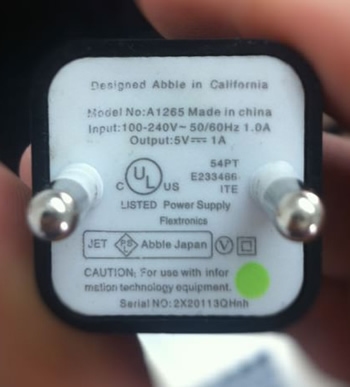Underwriters Laboratories (UL) has issued a public notice, warning consumers about an untold number of counterfeit iPhone, iPad and iPod USB power adapters for sale. These unauthorized adapters bear a counterfeit "UL" certification mark and have not actually been tested to meet UL's safety standards.
The two USB power adapters in question are marked with the same model number as a genuine Apple charger (A1265) and are very similar in appearance and markings. In fact, the shameless set of knock-offs claim to be "Designed Abble in California" or "Designed by China in California". Genuine Apple chargers authorized by the UL say, "Designed by Apple in California" by comparison.
These likely aren't the only USB chargers out there which mistakenly purport to be "UL certified", but knock-offs are to be expected when Apple's genuine adapters sell for about $29. However, third-party accessories should never claim to be UL certified without actually being so.
Last year, a teardown by Ken Shirriff revealed Apple's adapter is a high-quality device. Even so though, the total bill of materials for its USB adapter was something less than $4.66, making Apple's markup on the device substantial.
"There are strict rules governing the separation of dangerous line voltage and safe output voltage. There's supposed to be 3-4mm of 'creepage' and 'clearance.' Apple's charger exceeds that requirement at 6mm, while the off-brand device has less than 1mm." said Shirriff.
"I wondered how this [knock-off] power supply could have met the UL standards," Shirriff said. "It didn't list any safety certifications, or even a manufacturer. I suddenly realized that purchasing the cheapest possible charger on eBay from an unknown manufacturer in China could actually be a safety hazard. Note that this sub-millimeter gap is all that's protecting you and your phone from potentially-lethal 340 volts," he warned.
UL is an Illinois-based, science and technology safety certification organization who began in 1894. The organization has long been responsible for drafting numerous safety standards, including validating, testing, inspecting and auditing various electronics produced and sold in over a hundred countries worldwide.
